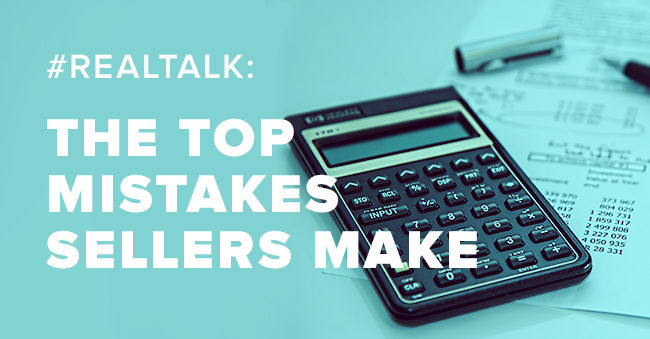#RealTalk: The Top Mistakes Sellers Make

It’s always a good idea to take a step back, evaluate how you’re doing, and set attainable goals (especially before the busy holiday season hits). But you can’t improve what you don’t measure, so it’s important to see where you stand and get a game plan in action. A good place to start? See if you’re making these all-too-common mistakes even the most seasoned sellers make.
1. Not knowing your numbers
A common mistake among sellers is to focus too much attention on how much money they’re getting from their sales and not enough attention on how much their business is costing them to operate.
“Not understanding that gross merchandise sales are not profits,” answers Chris Taylor, vice president of marketing for Page Mage, a vendor of social and branding tools for online sellers, when asked about big mistakes. It’s easy to get excited when the sales start rolling in, but Taylor reminds us that too many sellers focus on the sales and forget to factor in fees, shipping, and other costs when they calculate their profits. It is easy then to overestimate just how profitable your business is.
2. Chasing competitors’ prices
One of the biggest mistakes sellers make is to panic and chase sales by a competitor’s price alone, notes John Olson, who operates a number of e-commerce sites including American Pond Wholesalers. He’s noticed this among his competitors, whose product costs he knows well.
“Time after time I see them lowering prices to a level that cannot possibly cover their product costs, shipping fees, and their own labor or overhead costs,” he says. These sellers might find themselves in a much better position if they looked at their products a little broader and deeper.
“Far better,” he explains, “would be to seek out new items or ancillary items that few, if any sellers are offering. Sure, it takes a little more work, but it is a billion times more productive.”
Olson also recommends that sellers look for items they could group together. This not only offers better value to shoppers, but it saves sellers costs on shipping and overhead, too.
Robert Manigold, of that1otherdude, supports this idea of knowing your products and competitors well enough to find the niche that is yours alone. He notes that some sellers fail to understand when they should sell an item alone, or even when to sell the item versus selling the parts of the item.
“Selling a car one part at a time might be more lucrative than selling the entire car,” he suggests. Of course, you won’t know which way to go until you have a very clear understanding of your products and the products your competitors offer.
3. Your product descriptions aren’t up to par
Ever read a product description that puts you to sleep or doesn’t give you all the info you need? It’s easy to skip over this step when you sell online, but it’s oh-so-important if you’re going to convert shoppers into buyers. Creating detailed, engaging product descriptions is one of the most important things you can do to optimize your sales.
Here’s a quick checklist and some common mistakes to avoid:
DO:
- Be detailed and accurate, and be sure to anticipate questions shoppers might have.
- Describe how this product will solve a distinct dilemma for your shoppers. If you can clearly articulate how this product will fix a unique problem, you’ve just nailed the ultimate selling point for shoppers.
- Include keywords, but write for your shoppers, not a search engine. Descriptions should be engaging, friendly and provide all the necessary information visitors need to know. (This in itself will provide unique, search engine-friendly content.)
- Exclude references to other marketplaces or links to external sites.
- Spell-check and carefully proofread for typos and misspellings.
- Last, and certainly not least, be creative and have fun. This is your chance to talk directly to your shoppers and let them know what makes your product unique. Don’t forget to include how to use or style your product, any tips and tricks, and how exactly this product will benefit them.
DON’T:
- Write paragraphs longer than 3 to 4 sentences. While it’s always best to provide as much information as possible, use this important space wisely. Often it can look like a huge block of text that’s hard for a shopper to understand quickly. Break up your description into clearly defined paragraphs or bullets to make it scannable.
- Assume some details are obvious. Even if you have high-quality, detailed images, it’s still important to list key details about your product, such as what it’s used for and how it works.
- Use big words. It’s better to be clear and conversational than to use long words that sound impressive. You can easily lose a reader if you use superfluous words and plethoric language that makes it laborious for purchasers to digest. (See what we did there?)
Like this article? Find even more helpful tips on Auctiva EDU.



